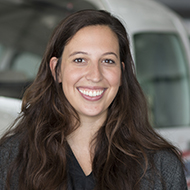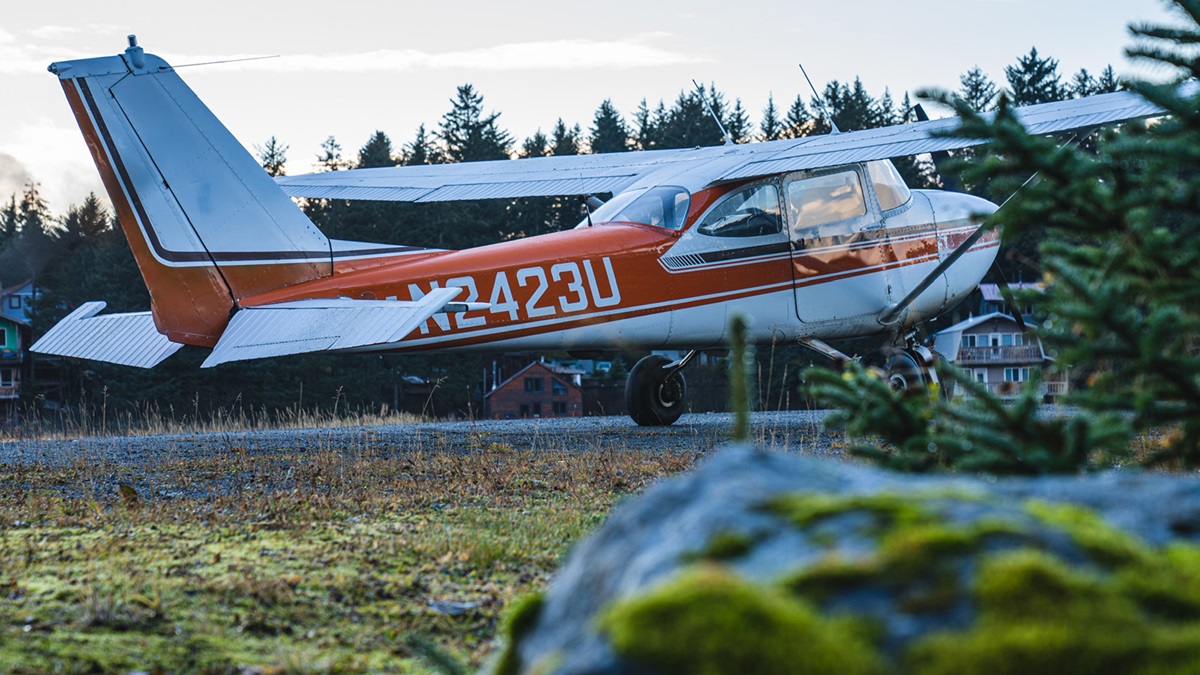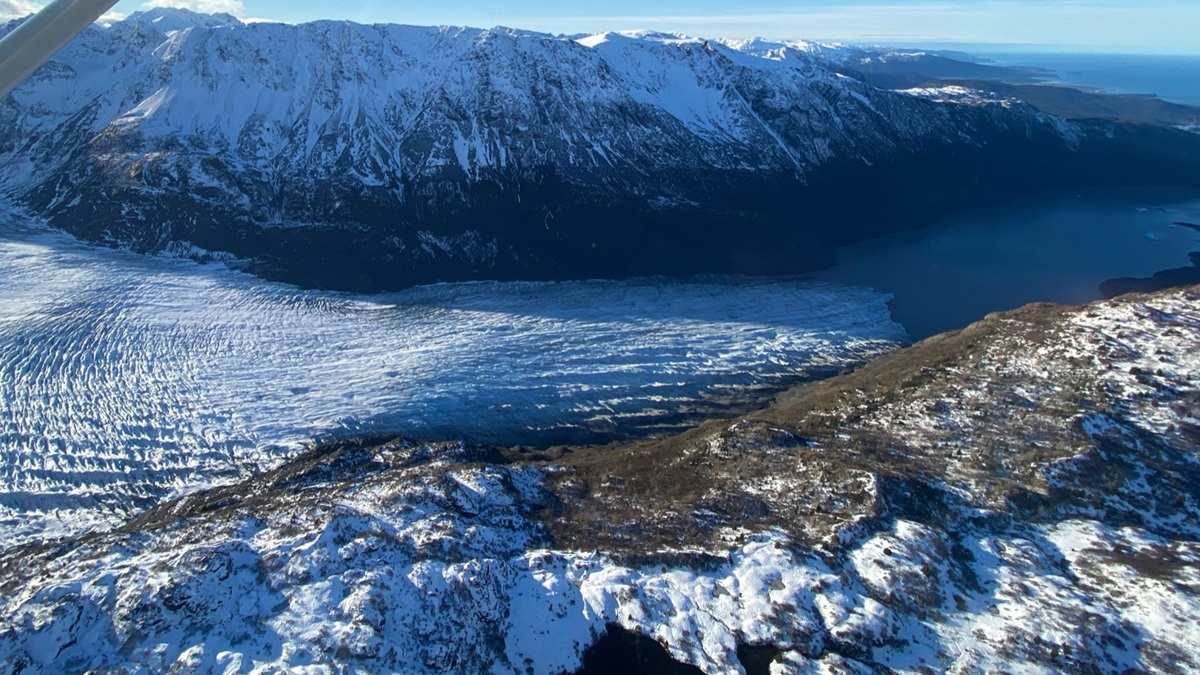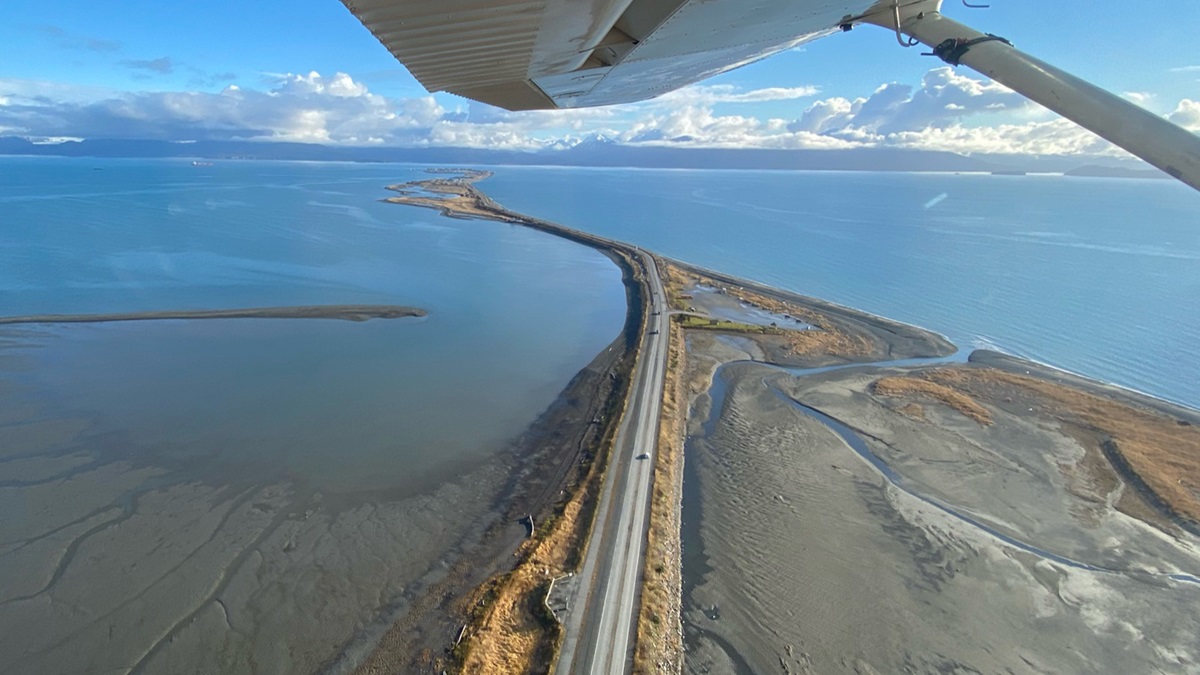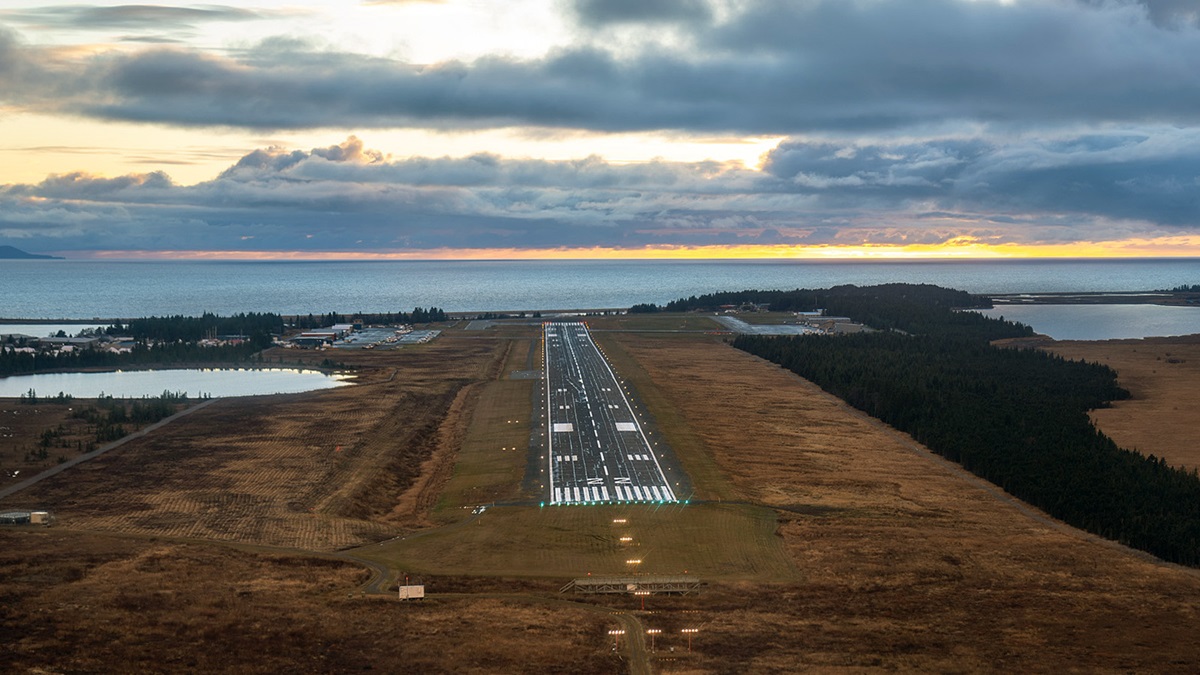Homer bound
Pilots dream of flying in Alaska; CFI and YouTube personality Chris Palmer lives it
Homer on the Fly






The town of more than 5,000 year-round residents looks out onto the Homer Spit, a glacier-formed moraine that stretches into the Kachemak Bay, and across the water to snowcapped mountains and ice fields. During high tide, the spit barely remains above sea level, and during low tide, the ocean floor is exposed for miles.
Most pilots have a dream of flying in Alaska, of testing themselves against a legendary place where even routine flights require above-average skill. It’s an enchanting place, and it’s very easy to fall under its spell.
AOPA Air Safety Institute video producer Kurt Sensenbrenner and I are in town to interview pilot Rob Olsen-Drye for the video Real Pilot Story: Lost Elevator. When CFI and YouTuber Chris Palmer learned of our plans to visit, he invited us to come fly with him. Of course, we said yes. Our first morning in town, we meet Palmer at a local diner to make a plan.
Over eggs Benedict and endless coffee Palmer tells us his story. Born in Utah, Palmer’s family moved to Alaska when he was a baby. He grew up fascinated by aviation, and he started his Angle of Attack brand in 2006 to create flight simulator-based videos. In 2010 he moved to Homer and is now best known in the aviation community for his educational and entertaining videos on YouTube, Instagram, and recently, TikTok. But the “influencer” part of his life is just a slice of a much bigger pie. He is an active flight instructor at his home airport, and he runs an online ground school. He’s proud to be an ambassador of Alaska; he wants us to love his home as much as he does.
After breakfast, we head to his hangar, meet his sweet German shepherd, Edel (short for Edelweiss), and check out his recently upgraded 1963 Cessna 172. Palmer had a new panel and new avionics put in the airplane, a process he documented on his YouTube channel.
He adores aviation, and he loves sharing it. His shelves are full of aviation books he’s been collecting since childhood, books he now shares with his own children. He’s humble, but you can tell he’s proud to show us the aviation life he’s built here.
We make tentative plans to fly soon and go our separate ways.
The views






Alaska time
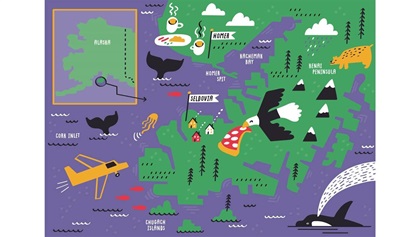 The next day, Palmer texts us that the weather is good enough for a scenic flight around the Kenai Peninsula. We head over to the airport, brief our route and the onboard survival gear with Palmer, and get going. Sensenbrenner and I will both get a chance in the left seat, and I’ll take leg one for our flight to the north.
The next day, Palmer texts us that the weather is good enough for a scenic flight around the Kenai Peninsula. We head over to the airport, brief our route and the onboard survival gear with Palmer, and get going. Sensenbrenner and I will both get a chance in the left seat, and I’ll take leg one for our flight to the north.
Palmer calls up Homer Flight Service and files a thorough flight plan before we make our way down to the runway. It’s a crisp, clear October morning, and it’s the first time Sensenbrenner and I have seen the sun since we arrived.
The transition from familiar to wild takes only a couple miles as we depart the pattern and head across the Kachemak Bay. We follow the Homer Spit, and then we’re over open water, the bay narrowing to our left, and to our right, widening into the Cook Inlet.
Within minutes, we’re contouring along snowcapped mountains, the peaks above us, looking ahead toward glaciers and ice fields, and down to moraines and milky blue runoff. We weave our way from glacier to glacier—Palmer tells us this is his favorite fight to do with visitors, and his favorite scenic flight to do anywhere. Where else does a practice area look like this?
Alaska flying is elite. I’m glad I’m wearing sunglasses because at one point I look around and think, How is this my life? while my eyes get a little misty. The first season of the television series Flying Wild Alaska came out the year I got my private pilot certificate—this flight is a bucket list moment.
We head up one fjord, feel a quick but aggressive jolt of turbulence, and turn around. Mountain flying can turn from fun to frightening in moments, and those first bumps are warnings to be heeded. We head back to Homer after dropping down a few thousand feet and checking the coast for any bears or moose (no luck).
I plant it in at Homer, annoyed at myself for not impressing Palmer with a perfect landing but laughing about it all the same, and Sensenbrenner and I switch seats. We’ll now fly across the bay again, but to the southeast this time toward the town of Seldovia and the Chugach Islands. Sensenbrenner is buzzing with excitement—this is his first time as PIC outside of the region where he learned to fly.
Little islands dot the coast as we head south, and a few even have houses. I’m imagining which one I’ll choose when I win the lottery, when I see a shadow in the water—and a tower of mist above it.
“Hey guys, I think I saw a blowhole,” I tell them.
“OK, Kurt, let’s practice turns around a point!” says Palmer as we start to circle and hope the ocean delivers. Moments later we all see it—an orca swimming just below the surface, and with a calf right next to her. All three of us are instantly kid-at-Disneyland excited, and Palmer takes the controls so Sensenbrenner can take in this Alaska moment.
“Don’t want to moose spin it in,” he says, referencing an accident in which a pilot is so distracted by the view outside that they lose control of the aircraft—such as when circling over wildlife, like whales or moose.
Beyond the couple people we see on our walk, the only signs of life are tendrils of smoke escaping from chimneys along the way. It’s eerily quiet and even our footsteps seem too loud. It’s beautiful, and it’s easy to see how once you’ve lived this life, it would be impossible to leave.And it turns out we haven’t stumbled upon just two whales. We’ve found a whole pod.
It feels like we’ve been plucked from reality and dropped into an episode of Planet Earth. We watch the pod surround some birds so the baby can try to catch one, the mist from the blowholes catching the light just right and creating a rainbow.
I thank Palmer for arranging this for us, asking jokingly if this is just another day in the life.
“I’ve seen whales before out here but never that many,” he tells us, and Sensenbrenner and I feel even more special that this day is extraordinary even by Alaskan standards.
The area to the south is so different from the glaciers of the first flight. Instead of ice and snow we have deep green forests, waterfalls, and tropical-blue waters. We watch an eagle fly down the valley next to us; we’ve left Planet Earth and are now in Tolkien’s Middle-earth.
We return to Homer, Sensenbrenner delivers a better landing than mine, and Palmer calls Homer radio to close our flight plan.
We drive into town and get the world’s biggest and tastiest slices of pizza from Fat Olives Restaurant before heading back to the hangar and recapping the flight together. The whales! The glaciers! The eagles! In a few short hours I had experienced two of the most memorable flights of my life.
Silver screen
That evening, still riding the high of a magnificent day of flying, we meet Palmer at the single-screen movie theatre in town. The line wraps around the building. It seems like the entire town wants to see the newly released film Dune. While grabbing some popcorn, I notice the wall next to concessions hosts black boards papered with dollar bills. A sign above it says, “Sell Out Shows,” and the bills have the name of the movie and the date. Star Wars, Madagascar, and The Chronicles of Narnia did very well in Homer, which is increasingly selling itself as a great place to live.
Luckily for us, the weather cooperates for another flying adventure. In our newly renamed group chat (now “House Atreides” after the family name of the heroes in Dune) Palmer asks if we want to check out Seldovia. We of course agree, and the waiting for a weather window begins. After a few hours of rain, Palmer says we’re good to go.
Seldovia is only about 15 minutes from Homer by air, and we brief the arrival before takeoff. Depending on the wind, we’ll probably enter a downwind for Runway 34. We can’t carry in extra speed because there’s little room for error on the 1,845-foot by 80-foot gravel strip. I’ll fly us in, Sensenbrenner will fly us out.
Flight plan filed, we depart to the southeast. Beams of light illuminate the gravel strip, glistening from the recent precipitation.
Flying with two CFIs in the front seat is interesting. Neither can let the other make too big of a mistake, but you also want to respect the other pilot’s experience and decision making. We made it clear on the ground in Homer that Palmer would be the true PIC in the event of an emergency, and I was content to log the flights as dual received.
On midfield downwind, it starts to rain. Palmer suggests I slow down, and I pop in the first notch of manual flaps. I turn onto base, feeling good, when he says, “And we’re high.” I add in more flaps and slow down.
“High and fast,” he continues. Sensenbrenner in the backseat wisely says nothing and I let Palmer know I’ve got it but also will go around if necessary—which my fragile pilot ego doesn’t want, but my flight instructor brain knows we might need. Five knots fast at home in California would be no issue, but that’s not the case here.
I eat up a few hundred feet of runway but touch down with more than enough time to stop, smiling over at Palmer and glad I got it on the first try. Another bucket list box checked: land on an Alaskan gravel strip.
We park in the corner and get ready to explore. We walk into town and across a bridge, and looking down into the cold, clear water I’m surprised to see jellyfish. We wander along a mossy boardwalk, past shops closed until the return of summer and stilted, multicolored homes. Beyond the couple people we see on our walk, the only signs of life are tendrils of smoke escaping from chimneys along the way. It’s eerily quiet and even our footsteps seem too loud. It’s beautiful, and it’s easy to see how once you’ve lived this life, it would be impossible to leave.
Running out of daylight, we head back to the airplane. Just as we do, we see an otter playing in the water by the field. It’s Sensenbrenner’s turn to log more Alaska time, and he hops in the front seat for his first gravel takeoff.
Palmer walks Sensenbrenner through the takeoff procedure, including the J-turn they’ll use to pick up some extra speed before turning down the runway. We’ll have to turn to the left almost immediately after departure to avoid terrain. I tighten up my seat belt and we’re on our way.
Sensenbrenner and Palmer get us off the ground with no problem, and you can see the confidence boost Sensenbrenner’s gained from Palmer trusting him at the controls with a complex takeoff like that. I knew it before but it’s solidified now—Palmer’s one of the best CFIs I’ve ever flown with.
We climb toward Homer abeam cliffs dripping in golden light. Far too soon, we’re back in the pattern for Homer.
A promise to return
We all have a last meal in town together, promising to see each other at EAA AirVenture Oshkosh, and Sensenbrenner and I promise to return to Homer in the summer for more adventures. Palmer seems like he genuinely enjoyed our visit, and seems genuinely sad to see us go, and I’m sad to leave.
The allure of Alaska is real, and the journey did not disappoint. It was as magnificent, memorable, challenging, and unique as I’d hoped, and the couple logbook entries I have from the forty-ninth state feel well-earned. To have a place like that—glaciers, mountains, beaches, waterfalls, wildlife—as a backyard is intoxicatingly unique. I understand now why aviators go to Alaska and never leave. Maybe one day I’ll do the same. 
